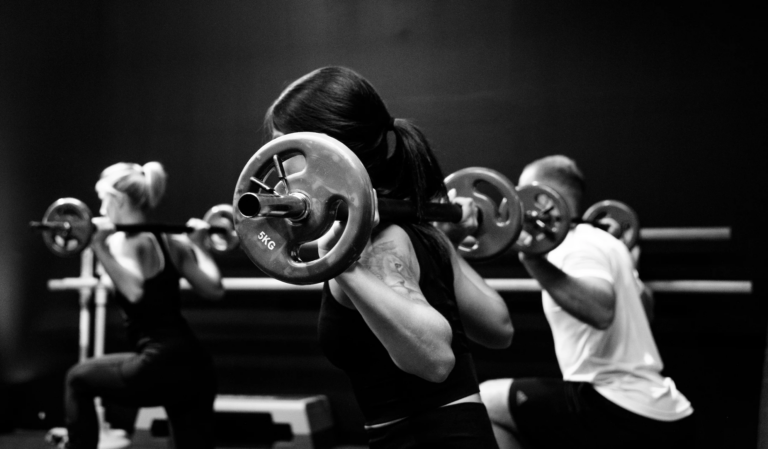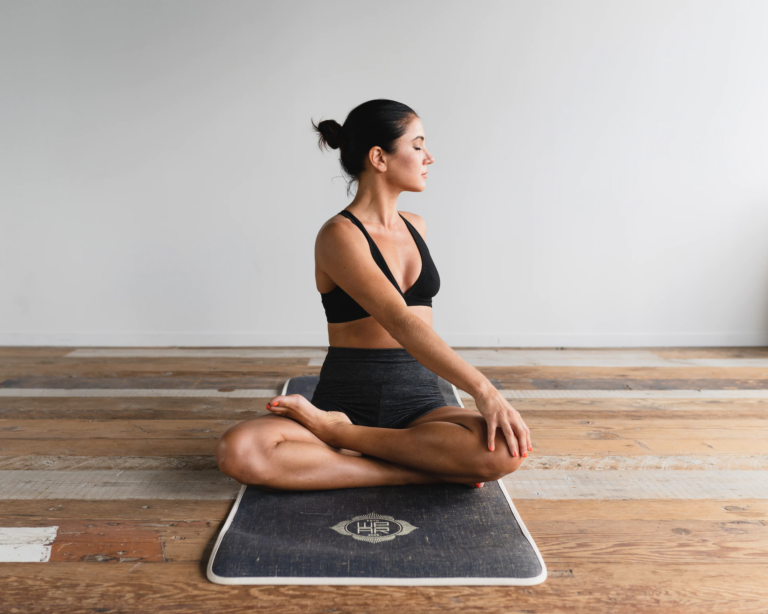
Vertigo is the sensation of feeling off balance and is a symptom of various conditions that can make you feel dizzy, or as if you’re spinning. Ringing in your ears can also be associated with vertigo, making it an uncomfortable experience for those that suffer it.
However, even if you’re experiencing an attack, that doesn’t mean that you can’t get up and moving. While there are plenty of exercises to avoid with vertigo, there are also several exercises that you can do even during an attack to help you stay active, while also taking care of your body and needs.
RELATED: Best Results-Driven Guide to Low Impact Workouts
What Causes Vertigo?

There are several reasons why you might be experiencing vertigo and is often caused by a problem with the balance mechanisms of the inner ear. Some reasons for vertigo include side effects from medication, vestibular neuronitis (or the inflammation of vestibular nerve cells), migraines, head injuries, excessive alcohol, an ear infection, or benign paroxysmal positional vertigo, or BPPV.
BPPV occurs when tiny calcium carbonate crystals, which normally reside in an inner ear, break loose and travel into the semicircular canals of the inner ear. This often happens when there is a sudden movement or change in your head position, like moving your head up or down.
What Causes Vertigo While Working Out?

Again, there can be several reasons for vertigo. You could be experiencing lack of oxygen, low blood sugar, low blood pressure, dehydration, overexertion, or even excessive use of motion machines.
And like mentioned, BPPV can also be the cause. While working out, it’s pretty common for your head to be swinging around constantly.
Whether it’s to pick up weights, to do crunches, rows, or even deadlifts, there are tons of reasons that your head whips around. So, it’s pretty common for those calcium carbonate crystals, which are used to help keep your balance, to break loose and cause vertigo.
Is It Okay to Exercise While You Are Having a Vertigo Attack?
Yes, however, this really depends on the exercise. Doing intense workouts will make it worse, but if you focus on stretching, strength training with your head lifted up, walking, any machine that doesn’t have you jostling your head around, you can still workout.
Just make sure that when working out, there isn’t a danger, as you don’t want to end up dropping weights or bars on your or those around you if something acts up again. Always listen and trust your body’s signals on when to stop.
Can Certain Exercises Cause Vertigo?
Unfortunately, yes. Certain workouts can end up triggering your vertigo more than others. Most exercises that involve rapid head movements or intense physical activity can cause or exacerbate vertigo.
While most of us enjoy finding rigorous and intense routines, as they get our blood pumping, it can cause some damage to those that experience vertigo more often than others.
What Exercises Trigger Vertigo?

There are several exercises that you’ll want to avoid if you’re experiencing vertigo. To look at a quick list of types of exercises to avoid with vertigo, read more.
This is not the complete list, however, so you should try to compare your exercises to the ones below before attempting or ask a medical professional or trainer before continuing.
READ MORE: Cardio or Abs First? What You Should Workout First and Why
9. Bent Over Rows
One of the most common reasons why vertigo can happen is through BPPV, which usually requires your head to be moving in a different way. Bent over rows, while does not have your heading moving per say, does require you to look down as you lift a heavy weight.
Not only does the weight have a possibility of causing dizziness, but the head position can disrupt the calcium crystals more.
8. Deadlifts
This is an intense exercise that sees you lifting heavy weights and moving upwards, which not only can trigger dizziness in itself due to the weight limit, but also cause calcium crystals to move much faster in your ear and cause imbalance.
This is one of the biggest exercises to avoid with vertigo.
7. Planks
Planks seem pretty easy and laid back, but holding the position of being held off the ground can cause strain and dizziness, especially due to the lack of breathing most do when doing this workout.
Lack of oxygen to the brain is a very common reason for vertigo, which means planks are a no-go when it comes to workouts during vertigo attacks.
6. Matt Exercises
There are a variety of exercises that you can do on a matt. From leg lifts, leg extensions, donkey kicks, clamshell, bridge and more, matt exercises are a common way to exercise at home and at the gym. Whether you’re a beginner or have been working out for a year, it’s a great go-to.
However, when dealing with vertigo, you’re more than likely want to keep your head level and elevated. Most of these workouts sees your head in precarious positions on the floor, while your body is moving above you.
5. Swimming
Swimming, while an absolutely amazing way to exercise as it reaches your whole body in terms of a workout, is not great. Not only are you moving your head from side to side, and even upside down during a flip turn, but you’re also not breathing as much as you should be.
This work out is a lung workout, as it trains you to not need to breath as often, and of course, when dealing with vertigo, you need oxygen. This is one of the biggest exercises to avoid with vertigo.
4. Lunges
Lunges look decent and easy, but it’s another big ‘no’ when it comes to workouts when experiencing vertigo symptoms. The drop-down steps are a great way to work out pretty much in any environment, but sadly, it’s too intense to deal with.
3. Sit-Ups and Crunches
While this could be considered a matt workout, it deserves its own category because it’s not always done on matts.
A lot of machines, or free weight workouts. are not really welcome with vertigo as well, and crunches and sit ups are one of them. Moving your head like that and the lack of breathing can be detrimental to an attack.
2. Burpees
This might be a no-brainer at this point. Burpees are horrid. And I’m not just saying that because I hate them with a passion, but because they jostle you around and see you doing a lot of sudden movements at once.
The calcium crystals in your ear will be flying when doing this. This is one of the biggest exercises to avoid with vertigo.
1. Step-Ups
You might be wondering why this one? You literally just step up! Like stairs!
But no, unfortunately, like with the rest of these workouts, the movements are too sudden and too intense, which creates a great trigger for vertigo.
What Movements Make Vertigo Worse?
Like mentioned, most movement where you’re excessively moving at a high intensity while experiencing vertigo can make it much worse. Due to the causes usually being with lack of oxygen to the brain, you’ll want to slow down and do easy moments, hydrate, and keep your head from doing any sudden movements.
Whether you’re experiencing symptoms from medication, have a lack of food or water, or experiencing BPPV, staying less active is ideal.
CHECK OUT: Workout Guide to Wall Pilates for Seniors
What Are the Easiest Exercises to Do During a Vertigo Attack?

Thankfully, that doesn’t mean that you can’t workout at all. There are some great workouts that you can do when dealing with a vertigo attack that is not only positive for your health but for your body too.
9. Walking Exercises
Walking is a great way to stay active even while dealing with vertigo.
While it can be a bit dangerous, or even uncomfortable, if you’re experiencing vertigo, but if you’re at the gym and don’t have the chance of falling or tripping into a street, this is a great way to work out.
8. Cycling
Another example of something that is great, yet could be dangerous if you’re outside, is cycling.
A stationary bike is obviously a lot better than outdoor riding as the dizziness can cause for some trouble, it’s still a great way to get in your work out while dealing with vertigo.
7. Jogging
Like walking, jogging that is done light, and indoors to prevent any harm, is a great way to get stay active while keeping your vertigo needs in check.
A light jog on the treadmill or around your yard can help sooth some symptoms.
6. Epley Maneuver
This is a great exercise to do when experiecing vertigo. While this doesn’t help your body, this helps your vertigo and head, which in the end, helps your health all together.
To do this maneuver, you should lie down on your back, turn your head to the left for one minute, and then the right for one minute. After, turn your whole body to the right, head facing towards the floor for one minute, then sit up slowly, head tilted forward for 1 minute.
5. Balance Training
While Yoga can be considered as a balance trainer, there are better, easier ways to do this when dealing with vertigo.
Balance training is a simple exercise that has you walking heel to toe or standing on one foot and balancing. This strengthens the muscles used to balance and improves your stability, which can help reduce vertigo.
4. Tai Chi
This is another, more gentle way to exercising that promotes balance and stability.
It involves slow, flowing movements that help restrain the vestibular system and improve coordination.
3. Yoga
Yoga is a great way to improve balance at a slow pace.
However, those who enjoy intense yoga should refrain from doing that. Only low intense yoga should be done, as intense workouts can trigger vertigo.
2. Eye Movement Exercises
This might be a strange one, but eye exercises can be a great way to help and solve vertigo that you might be dealing with.
You can extend one arm forward with the thumb raised, and then focus the eyes on that thumb, and then move the thumb slowly from side to side, keeping your eyes on it. This is a great way to center yourself during an attack.
1. Stairs
Walking up and down the stairs while dealing with vertigo is easy and safe and is a great way to stay active, keep in shape, and combat future attacks.
What You Should Do If You Experience a Vertigo Attack During a Workout
If you suddenly feel an attack during a workout, the best option is to do the Epley maneuver, or repositioning maneuver, which is used by medical professionals to treat vertigo or BPPC.
To do this maneuver, you should lie down on your back, turn your head to the left for one minute, and then the right for one minute. After, turn your whole body to the right, head facing towards the floor for one minute, then sit up slowly, head tilted forward for 1 minute.
Take a break from your workout, do not push your body further or you might get ill or experience vertigo again. If it doesn’t go away, or your concerned with the attack, you should see a doctor to check out the symptoms and what to do to prevent further attacks.
RELATED: Best Pull Exercises with Dumbbells
Tips to Avoid Vertigo Attacks During Workouts

Eat 2-3 Hours Before a Workout
A lack of food can be a huge role into experiencing vertigo at the gym or when working out. Hunger can make the body weak, as you don’t have enough fuel in your system to do intense workouts. But eating something a couple of hours before going is a great way to prevent any attacks.
A lot of people enjoy waking up and going right away before starting their day. If you do this, try snacking on a protein bar, or making a protein shake with some fruits or veggies to give your body what it needs.
Always Keep Hydrated
Another big reason that vertigo can happen is from lack of water. Dehydration is a huge cause for vertigo. Staying hydrated is a great way to prevent vertigo.
Keeping a large water bottle with you as you go from machine to machine, or at your station while working out can help prevent any attacks.
Don’t Risk Exercises That Can Bring on an Attack
Intense workouts are a great way to start the day for some, but it can also lead to more injuries if you’re not taking care of your body.
Intense workouts also have you moving your body a bit more than other workouts, which has been proven to cause vertigo with sudden movements. Switching up your exercises and making sure you include less intense movements is a great way to prevent vertigo, as well as train other areas of your body.
Don’t Workout Excessively
Related to the above entry, make sure you’re not working out too much. The more you work out, the more food and water you’re going to need, and oftentimes you won’t keep up with the intake while working out, which can create dehydration or lack of food, which then in turn will cause vertigo.
Doing shorter, smaller spurts is a better way to not only train your body, as it doesn’t truly need long sessions, but make sure you’re staying up with your health.
Don’t Ignore Stress or Warning Signs
When you feel an attack coming on, the best plan is to stop what you’re doing before it gets worse. Pushing through an attack can lead to serious injuries and can cause medical attention. Don’t ignore the signs. If you’re experiencing frequent attacks, you might want to see a doctor for medical advice.
While most people experience vertigo every once in a while, depending on their body’s current state, experiencing it regularly is not something that you should deal with.
Conclusion
Vertigo is an uncomfortable experience that many of us experience, but that shouldn’t stop us from wanting to stay healthy and fit. There are ways that we can prevent future attacks, and there are even exercises to avoid with vertigo if you have a history.
While vertigo is not a dangerous symptom on its own, combining it with heavy weights or dealing with other factors, it can be dangerous. Learning how to combat it, how to solve it, and ways to avoid it all together is ideal. Always speak to your doctor if you have further questions or concerns about treating vertigo.

